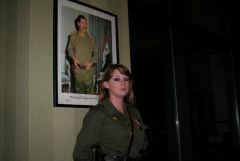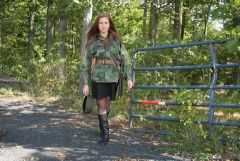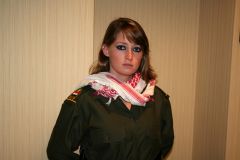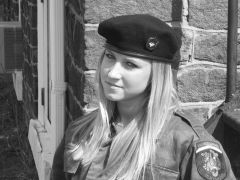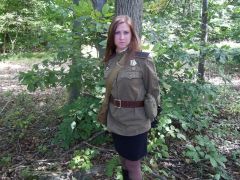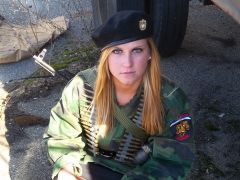
medina777
Past Contributor-
Posts
15 -
Joined
-
Last visited
Profile Information
-
Gender
Male
-
Location
USA
-
Interests
Iraqi militaria (Saddam era), Serbian / Croatian militaria
Recent Profile Visitors
medina777's Achievements
-
Female officer in the Iraqi Regular Army, 1991
medina777 commented on medina777's gallery image in Category 1: Personal Collections
-
WW2 Soviet Russian Female Medic Firing At The Invaders, 1942...
medina777 commented on medina777's gallery image in Category 1: Personal Collections
-
Serbian Paramilitary Unit "Arkan's Tigers", Female Combatant, Bosnia 1992
medina777 commented on medina777's gallery image in Category 1: Personal Collections
Hello again Paul!! Thanks again for liking my Serbian Volunteer Guard photo(s)!!!! The three women that fought in Arkan's Tigers has always fascinated me, as they seem to have nearly been forgotten by contemporary historians. I found out about them in 2005 or so, while doing research on the Tigers. I do not know "Lena's" real name (that is her nom de guerre), but I believe it was Aleksandra. The other two dark haired girls were Ljiljana and Tanja. My friend Kristen (the model in the photos) looks almost exactly like Lena, and is the same age as she was (20 years old). Ljiljana survived the war, and went on to fight in Kosovo as part of the regular Serbian/Yugoslav Army, and was killed in action. Not much is known of Tanja. Lena was indicted I think in 2004 or 2005 for war crimes (she commanded a platoon that took over a Bosnian town and personally executed many of the captives). I read about her in a book many years ago, and she was blond haired, a great fighter, and violently ruthless with most prisoners. I'm still researching more info on her, as she was the only female officer in the SDG. She had a reputation for leading her troops from the front (kind of like Arkan), and was considered a true Serbian hero. The most amazing thing (to me) is that she looked like my friend Kristen in the photos!!! It is just so interesting to me. I'm glad you are learning about the Tigers; they are a very interesting paramilitary unit, and I think, the best of the war. Thanks again, and take care, Paul. Nice to know you!! Sincerely, Mark -
Bosnian-Serb Army, Summer 1993
medina777 commented on medina777's gallery image in Category 1: Personal Collections
-
Saddam's Iraq: An Iraqi Female Soldier, Baghdad, 1991
medina777 posted a gallery image in Category 1: Personal Collections
-
WW2 Soviet Russian Female Medic Firing At The Invaders, 1942...
medina777 posted a gallery image in Category 1: Personal Collections
A Soviet female medic returns fire from her TT-33 pistol during the summer of 1942, as the Fascist Invaders attack her unit. She is wearing a pre-war brown leather jacket with medical collar tabs, a navy blue uniform skirt, black leather boots and black stockings, and currently has an officer's map case as her medical bag was left behind in the attack. What little medicine she could save is in that case, and she is trying to keep the Germans at bay long enough to link up with the rest of her medical detachment.© Mark Landis, RED STAR MILITARIA
-
A portrayal of a female member of the Iraqi Ba'ath Party (Revolutionary Command Council), standing in a hotel in Baghdad in November of 1990, waiting to give a short press conference on the current situation in Kuwait. I think Saddam would be proud of this loyal Ba'athist Comrade...
© Mark Landis, RED STAR MILITARIA
-
"Arkan's Tigers" (Serbian Volunteer Guard) photo. This living history / reenactment photo portrays a female combat member of the infamous paramilitary unit "Arkan's Tigers" (there were three female members of the Serbian Volunteer Guard from 1991-1995, that saw combat operations with the unit in Croatia and Bosnia). There are only a few known photos of these women in action with the Tigers, all of which are very rare and nearly impossible to find. Many women worked in staff, communications, and operations positions in rear headquarters areas for Zeljko "Arkan" Raznatovic, but history only records three that fought in combat. As with all of the combat uniforms of Arkan's Tigers, the style and appearance changed from their inception on October 11th, 1990, until their disbandment in April of 1996. This specific photo attempts to portray "Lena", an officer in the SDG, participating in combat operations in Bosnia, wearing one of the early versions of the female uniform (1991-1993). The Serbian Volunteer Guard first wore blue MILICIJA ("Militia/Police") uniforms in the early days of the war, followed shortly thereafter by various green uniforms, Serbian "tiger stripe" camouflage uniforms, M89 camouflage sets, and then M93 camouflage. They also wore all black uniforms, and eventually NATO-style woodland camouflage. All of the uniforms (except the Milicija ones) had the SDG embroidered patch on the upper right sleeve, and the "tiger's head" (TIGROVI) patch on the upper left sleeve. Sometimes, however, they are seen wearing these patches on the opposite sides than normal. The female combat members originally wore the uniform jackets with black heavyweight cotton skirts, black stockings, and black leather "riding-style" boots. Eventually the rigors of combat necessitated a switch to the more commonly seen camouflage pants, sometime around late 1993. Green, black, and then eventually red berets were worn, with either the Krajina TO rectangular Serbian flag badge, the Serbian and Krajina Police flag on a gold ornamental base, a metal "Tigers" badge, or a small embroidered SDG badge. Serbian M89/M93 camouflage caps were also worn, as were black wool hats, face masks, and bandannas on occasion. JNA breast badges indicated rank; Zeljko "Arkan" Raznatovic, who wore no rank insignia, promoted his troops to officer rank and at least three to general officers - although only the SDG recognized the ranks; in this photo, "Lena" is ostensibly a Potpukovnik (Lt. Colonel).
© RED STAR MILITARIA
-
"Lena" from the Serbian Volunteer Guard, Bosnia, Summer of 1992
medina777 posted a gallery image in Category 1: Personal Collections
"Arkan's Tigers" (Serbian Volunteer Guard) photo. This living history / reenactment photo portrays a female combat member of the infamous paramilitary unit "Arkan's Tigers" (there were three female members of the Serbian Volunteer Guard from 1991-1995, that saw combat operations with the unit in Croatia and Bosnia). There are only a few known photos of these women in action with the Tigers, all of which are very rare and nearly impossible to find. Many women worked in staff, communications, and operations positions in rear headquarters areas for Zeljko "Arkan" Raznatovic, but history only records three that fought in combat. As with all of the combat uniforms of Arkan's Tigers, the style and appearance changed from their inception on October 11th, 1990, until their disbandment in April of 1996. This specific photo attempts to portray "Lena", an officer in the SDG, participating in combat operations in Bosnia, wearing one of the early versions of the female uniform (1991-1993). The Serbian Volunteer Guard first wore blue MILICIJA ("Militia/Police") uniforms in the early days of the war, followed shortly thereafter by various green uniforms, Serbian "tiger stripe" camouflage uniforms, M89 camouflage sets, and then M93 camouflage. They also wore all black uniforms, and eventually NATO-style woodland camouflage. All of the uniforms (except the Milicija ones) had the SDG embroidered patch on the upper right sleeve, and the "tiger's head" (TIGROVI) patch on the upper left sleeve. Sometimes, however, they are seen wearing these patches on the opposite sides than normal. The female combat members originally wore the uniform jackets with black heavyweight cotton skirts, black stockings, and black leather "riding-style" boots. Eventually the rigors of combat necessitated a switch to the more commonly seen camouflage pants, sometime around late 1993. Green, black, and then eventually red berets were worn, with either the Krajina TO rectangular Serbian flag badge, the Serbian and Krajina Police flag on a gold ornamental base, a metal "Tigers" badge, or a small embroidered SDG badge. Serbian M89/M93 camouflage caps were also worn, as were black wool hats, face masks, and bandannas on occasion. JNA breast badges indicated rank; Zeljko "Arkan" Raznatovic, who wore no rank insignia, promoted his troops to officer rank and at least three to general officers - although only the SDG recognized the ranks; in this photo, "Lena" is ostensibly a Potpukovnik (Lt. Colonel).© RED STAR MILITARIA
-
Soviet Russian WW2 Female Soldier
medina777 posted a gallery image in Category 1: Personal Collections
-
BOSNIAN-SERB ARMY / ARMY OF THE SERB REPUBLIC ("Vojska Republike Srpske") photo. This living history / reenactment photo portrays a female combat member of an infantry unit of the VRS (Bosnian-Serb Army). Many women worked in staff, communications, and operations positions in rear headquarters areas for the military forces of the Republika Srpska, but there were large numbers that served in front line brigades, as well as attached paramilitary units and militias. As with all of the female combat uniforms of the Bosnian-Serb Army, the style and appearance changed from their inception on August 12th, 1992, until the end of the war in 1995. This specific photo attempts to portray a female soldier participating in combat operations in Bosnia, wearing one of the early versions of the female uniform (circa 1993).
© RED STAR MILITARIA
-
Arkan's Tigers Female Combatant, Bosnia 1992
medina777 posted a gallery image in Category 1: Personal Collections
"Arkan's Tigers" (Serbian Volunteer Guard) photo. This living history / reenactment photo portrays a female combat member of the infamous paramilitary unit "Arkan's Tigers" (there were three female members of the Serbian Volunteer Guard from 1991-1995, that saw combat operations with the unit in Croatia and Bosnia). There are only a few known photos of these women in action with the Tigers, all of which are very rare and nearly impossible to find. Many women worked in staff, communications, and operations positions in rear headquarters areas for Zeljko "Arkan" Raznatovic, but history only records three that fought in combat. As with all of the combat uniforms of Arkan's Tigers, the style and appearance changed from their inception on October 11th, 1990, until their disbandment in April of 1996. This photo attempts to portray "Ljiljana", a soldier in the SDG, participating in combat operations in Bosnia, wearing one of the early versions of the female uniform (1991-1993). The Serbian Volunteer Guard first wore blue MILICIJA ("Militia/Police") uniforms in the early days of the war, followed shortly thereafter by various green uniforms, Serbian "tiger stripe" camouflage uniforms, M89 camouflage sets, and then M93 camouflage. They also wore all black uniforms, and eventually NATO-style woodland camouflage. All of the uniforms (except the Milicija ones) had the SDG embroidered patch on the upper right sleeve, and the "tiger's head" (TIGROVI) patch on the upper left sleeve. Sometimes, however, they are seen wearing these patches on the opposite sides than normal. The female combat members originally wore the uniform jackets with black heavyweight cotton skirts, black stockings, and black leather "riding-style" boots. Eventually the rigors of combat necessitated a switch to the more commonly seen camouflage pants, sometime around late 1993. Green, black, and then eventually red berets were worn, with either the Krajina TO rectangular Serbian flag badge, the Serbian and Krajina Police flag on a gold ornamental base, a metal "Tigers" badge, or a small embroidered SDG badge. Serbian M89/M93 camouflage caps were also worn, as were black wool hats, face masks, and bandannas on occasion. JNA breast badges indicated rank; Zeljko "Arkan" Raznatovic, who wore no rank insignia, promoted his troops to officer rank and at least three to general officers - although only the SDG recognized the ranks.© RED STAR MILITARIA
-
Serbian Volunteer Guard, Bosnia, Summer 1993
medina777 posted a gallery image in Category 1: Personal Collections
"Arkan's Tigers" (Serbian Volunteer Guard) photo. This living history / reenactment photo portrays a female combat member of the infamous paramilitary unit "Arkan's Tigers" (there were three female members of the Serbian Volunteer Guard from 1991-1995, that saw combat operations with the unit in Croatia and Bosnia). There are only a few known photos of these women in action with the Tigers, all of which are very rare and nearly impossible to find. Many women worked in staff, communications, and operations positions in rear headquarters areas for Zeljko "Arkan" Raznatovic, but history only records three that fought in combat. As with all of the combat uniforms of Arkan's Tigers, the style and appearance changed from their inception on October 11th, 1990, until their disbandment in April of 1996. This specific set of photos attempts to portray "Lena", an officer in the SDG, participating in combat operations in Bosnia, wearing one of the early versions of the female uniform (1991-1993). The Serbian Volunteer Guard first wore blue MILICIJA ("Militia/Police") uniforms in the early days of the war, followed shortly thereafter by various green uniforms, Serbian "tiger stripe" camouflage uniforms, M89 camouflage sets, and then M93 camouflage. They also wore all black uniforms, and eventually NATO-style woodland camouflage. All of the uniforms (except the Milicija ones) had the SDG embroidered patch on the upper right sleeve, and the "tiger's head" (TIGROVI) patch on the upper left sleeve. Sometimes, however, they are seen wearing these patches on the opposite sides than normal. The female combat members originally wore the uniform jackets with black heavyweight cotton skirts, black stockings, and black leather "riding-style" boots. Eventually the rigors of combat necessitated a switch to the more commonly seen camouflage pants, sometime around late 1993. Green, black, and then eventually red berets were worn, with either the Krajina TO rectangular Serbian flag badge, the Serbian and Krajina Police flag on a gold ornamental base, a metal "Tigers" badge, or a small embroidered SDG badge. Serbian M89/M93 camouflage caps were also worn, as were black wool hats, face masks, and bandannas on occasion. JNA breast badges indicated rank; Zeljko "Arkan" Raznatovic, who wore no rank insignia, promoted his troops to officer rank and at least three to general officers - although only the SDG recognized the ranks; in this photo, "Lena" is ostensibly a Potpukovnik (Lt. Colonel).© RED STAR MILITARIA
-
Female officer in the Iraqi Regular Army, 1991
medina777 posted a gallery image in Category 1: Personal Collections
FEMALE COMMUNICATIONS OFFICER IN SADDAM'S ARMY: Historical reenactment / living history photo. This unique photo portrays a female member of the Regular Iraqi Army, circa 1991. From 1980 to 1991, female volunteers were an important part of the Iraqi military under the presidency of Saddam Hussein. Women served in the Ba'ath Militia ("Popular Army") and the Regular Iraqi Army in staff service, communications, medical, and security roles. This reenactment shows Mulazim awwal (1st Lieutenant) Amina Hariri in Baghdad, in July of 1991. She is dressed in one version of the female two-pocket jackets, and is wearing her golden Ba'ath Party Badge, her General Federation of Iraqi Women pin (showing President Saddam), and her recently awarded Um al-Ma'arik medal for her participation in military operations in occupied Kuwait from 1990-1991.© Red Star Militaria
-
Same here; I can't find a way to upload a photo for the contest. Help, please!



